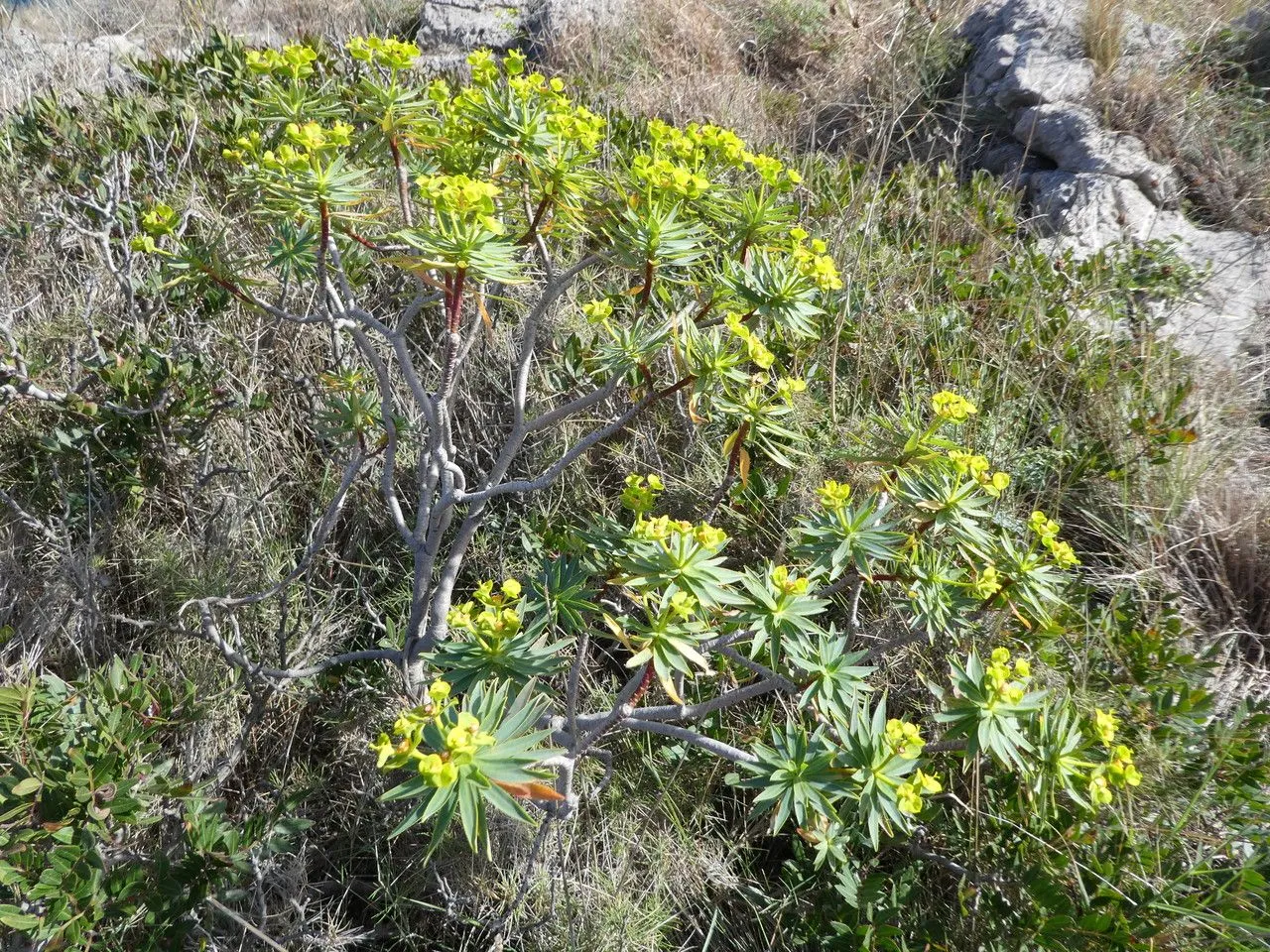
Author: L.
Bibliography: Sp. Pl.: 462 (1753)
Year: 1753
Status: accepted
Rank: species
Genus: Euphorbia
Vegetable: False
Observations: Canary Is., Medit.
Woody spurge, known scientifically as Euphorbia dendroides, is a striking and resilient plant that belongs to the family Euphorbiaceae. The plant is renowned for its robust, tree-like appearance that sets it apart from other members of the spurge family.
Native to the Canary Islands and the Mediterranean region, Woody spurge flourishes in the Mediterranean climate, known for its dry summers and mild, wet winters. Its adaptive nature allows it to thrive in rocky, arid terrains where few other species can survive, making it a key component of its native habitat’s ecosystem.
Euphorbia dendroides is particularly notable for its unique growth pattern and striking features. It can grow to an impressive height, forming a dense, bushy structure with a woody base, which is reflected in its common name. The leaves of Woody spurge are typically narrow, lance-shaped, and arranged in a spiral around the stems, which are often tinged with shades of red or green depending on the season.
One of the most aesthetically pleasing aspects of the plant is its seasonal cycle. During the spring, it produces bright, yellowish-green flowers clustered in cymes, which are visually captivating and attract various pollinators. By summer, the plant undergoes a dramatic transformation, shedding its leaves to conserve water during the hot, dry months, only to regrow them in the autumn. This deciduous behavior is quite rare among spurges, making Euphorbia dendroides a subject of interest for botanists and plant enthusiasts alike.
Aside from its ornamental value, Woody spurge also has ecological importance. Its presence contributes to soil stability in its native regions, preventing erosion in the rocky landscapes of the Mediterranean and Canary Islands. Moreover, its ability to thrive in harsh conditions can be beneficial for ecological restoration projects in similar climates.
Euphorbia dendroides, cataloged in the seminal work ‘Species Plantarum’ in 1753, has been studied extensively since its classification by the botanist Linnaeus, known by the initial “L.” in botanical citations. Its longstanding record in botanical literature underscores its significance within the plant kingdom.
In summary, Woody spurge is a unique and versatile plant, well-suited to its native habitats in the Mediterranean and Canary Islands. Its striking appearance, seasonal transformations, and ecological contributions make it a valuable species both in nature and horticulture.
Eng: tree spurge, woody spurge
Swe: trädtörel
En: Woody spurge, Tree spurge
Sq: Flom, Zgjom
Ar: لبين (لِبين)، لبينه (لِبيْنه), فربيون شجري, Libbeina
Ca: Lleterassa, Mula
Zh: 树大戟
Co: Lattonu
Hr: Drvenasta mlječika
Cs: Pryšec dřevnatý
Nl: Boomvormige Wolfsmelk
Fi: Puutyräkki
Fr: Euphorbe arborescente
De: Baum-Wolfsmilch, Wolfsmilchbaum
El: Ευφορβία η δενδροειδής
He: חלבלוב השיח
It: Euforbia arborescente
No: Trevortemelk
Es: Titimalo, Lechetrezna arbórea, Titímalo árbol
Sv: Trädtörel
Zh-hant: 樹大戟
© copyright of the Board of Trustees of the Royal Botanic Gardens, Kew.
© copyright of the Board of Trustees of the Royal Botanic Gardens, Kew.
© copyright of the Board of Trustees of the Royal Botanic Gardens, Kew.
Taken Mar 7, 2022 by Hansjoerg Hageld (cc-by-sa)
Taken Mar 7, 2022 by Hansjoerg Hageld (cc-by-sa)
Taken Mar 15, 2021 by Luigi Marino (cc-by-sa)
Taken Feb 22, 2021 by llamas lucia (cc-by-sa)
Taken Apr 1, 2021 by Llandrich anna (cc-by-sa)
Taken Apr 15, 2013 by Photoflora – Benoit BOCK (©)
Taken Jun 6, 2006 by Tela Botanica − Sylvain PIRY (cc-by-sa)
Taken May 15, 2021 by Steve LE BRIQUIR (cc-by-sa)
Taken Apr 1, 2021 by Llandrich anna (cc-by-sa)
Taken Apr 2, 2017 by Tela Botanica − Bellour SIMON (cc-by-sa)
Taken Oct 29, 2009 by Tela Botanica − Yoan MARTIN (cc-by-sa)
Taken Apr 22, 2014 by Tela Botanica − Liliane Roubaudi (cc-by-sa)
Taken Mar 24, 2021 by Llandrich anna (cc-by-sa)
Taken Jan 29, 2022 by Anton Gjeldum (cc-by-sa)
Taken Apr 1, 2021 by Llandrich anna (cc-by-sa)
Taken Apr 2, 2017 by Tela Botanica − Bellour SIMON (cc-by-sa)
Taken Mar 5, 2022 by Francois Mansour (cc-by-sa)
Taken Mar 7, 2022 by Hansjoerg Hageld (cc-by-sa)
Taken Mar 7, 2022 by Hansjoerg Hageld (cc-by-sa)
Taken Apr 1, 2021 by Llandrich anna (cc-by-sa)
Taken Nov 11, 2021 by André Hyvrier (cc-by-sa)
Taken Feb 21, 2021 by Antoine Rerolle (cc-by-sa)
Taken Dec 29, 2021 by Julien Bruyelle (cc-by-sa)
Taken Oct 21, 2018 by Diana Gavino (cc-by-sa)
Taken May 2, 2021 by Stella Mexi (cc-by-sa)
Taken Oct 15, 2009 by Photoflora – Benoit BOCK (©)
Taken Mar 25, 2007 by Tela Botanica − Errol VELA (cc-by-sa)
Taken Apr 18, 2014 by Tela Botanica − Liliane Roubaudi (cc-by-sa)
Taken May 17, 2016 by Tela Botanica − Martine MARTHOURET ROBERT (cc-by-sa)
Taken Apr 23, 2018 by huy HO (cc-by-sa)
Growth habit>: Shrub
Ph maximum: 5.5
Ph minimum: 5.0
Light: 8
Atmospheric humidity: 3
Bloom months: [‘apr’, ‘may’, ‘jun’]
Soil nutriments: 4
Family: Myrtaceae Author: (F.Muell.) K.D.Hill & L.A.S.Johnson Bibliography: Telopea 6: 402 (1995) Year: 1995 Status:…
Family: Rubiaceae Author: Pierre ex A.Froehner Bibliography: Notizbl. Bot. Gart. Berlin-Dahlem 1: 237 (1897) Year:…
Family: Sapindaceae Author: Koidz. Bibliography: J. Coll. Sci. Imp. Univ. Tokyo 32(1): 38 (1911) Year:…
Family: Asteraceae Author: A.Gray Bibliography: Pacif. Railr. Rep.: 107 (1857) Year: 1857 Status: accepted Rank:…
Family: Fabaceae Author: Medik. Bibliography: Vorles. Churpfälz. Phys.-Ökon. Ges. 2: 398 (1787) Year: 1787 Status:…
Family: Aspleniaceae Author: (Cav.) Alston Bibliography: Bull. Misc. Inform. Kew 1932: 309 (1932) Year: 1932…